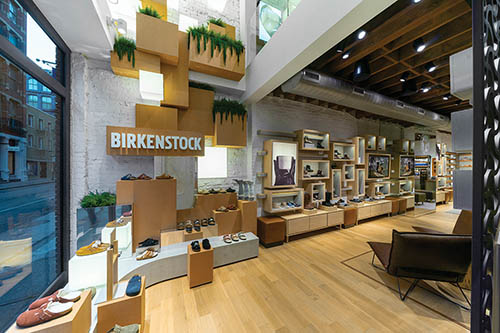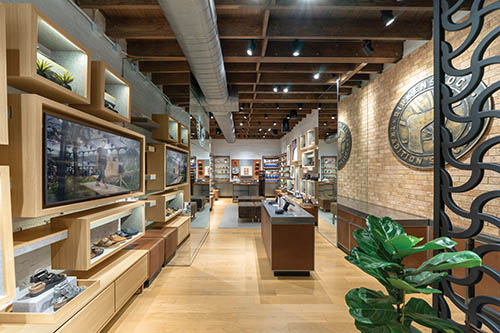— By Scott Faucheux —
How modular and sustainable flooring is shaping retail design.
In today’s dynamic retail and restaurant landscapes, adaptability is key. Consumers are craving experiences that jump off the page –– literally. The internet has transformed our perceptions and expectations of shopping, fulfillment and convenience, creating a constant demand for what is new and popular. It is worth noting that a brand’s physical store and online presence may have different goals, and transforming a physical space can be more complex than updating a digital narrative.
Retailers face far more complexity when it comes to creating physical spaces that are visually appealing, adaptable, sustainable and cost-effective. They must simultaneously support transactions, embody the brand ethos and breathe life into the customer experience.
With the right design, these spaces can seamlessly evolve sustainably and innovatively while remaining true to their broader vision. Central to a flexible design strategy is the role of flooring. As a foundational element, flooring dictates the aesthetic ambiance and influences a space’s ability to adapt without contributing significantly to its environmental footprint.
Sustainable Flooring: Beyond the Basics
Flooring is often the most expansive element in a space. It sets the tone for a retail ambiance and its environmental footprint. The initial choices you make in flooring can profoundly impact how a patron interacts with the space and how it makes them feel. Consequently, it is important to select materials that are not only sustainable on Day 1 but will continue to be over time as they change, shift and adapt. It is equally important to understand that these decisions are being made for the long term, which has implications for upfront cost and the need for durability.

Bamboo plank floors have emerged as a favorite in sustainable design, and for good reason. Bamboo, a rapidly renewable resource, grows much faster than traditional hardwoods, making it a top choice for those looking to minimize deforestation. Recycled rubber is another innovative choice that transforms waste into wonder. Old tires, which would otherwise end up in landfills, are given a new lease on life as durable, shock-absorbent flooring. Perfect for high-traffic areas, recycled rubber is environmentally responsible and ergonomically superior, offering comfort underfoot.
The caveat to these exciting new materials is that they sometimes come at a higher initial cost. This can be a deterrent for businesses operating on tight budgets, but using sustainable materials sends an important message to consumers about what the brand values, which is essential in today’s authenticity-driven economy. Moreover, the up-front investment is often offset by reduced maintenance costs over time when selecting a more durable flooring material.
Another consideration for new-to-market materials is the supply chain; with fewer suppliers, retailers may face procurement delays or product quality inconsistencies. It is essential to partner with reliable companies — particularly those with responsible cultivation and transportation practices –– and plan for potential lead times. Retail designers navigate these setbacks regularly and can be invaluable in helping to phase-build timelines and creatively work around product abnormalities, ensuring the result is as beautiful as it is functional.
Additional material options include reclaimed timber, a unique flooring option because its history can tell a compelling visual story. Every knot, grain and imperfection speaks of a past life, adding a depth of character to new retail spaces. By reusing wood from old structures, we are preserving history and reducing the demand for new lumber, helping to combat deforestation. Terrazzo is another durable and customizable solution with its blend of recycled aggregates set in cement or resin. Cork, harvested without felling the tree, brings warmth and acoustic benefits. Linoleum, made from natural materials like linseed oil and jute, is biodegradable and has been a trusted choice for decades.
Modular Flooring: Flexibility with Caveats
The concept of modularity has been a game-changer in the design world. At TPG Architecture, we’ve embraced this approach, recognizing the myriad of benefits it brings to the table, especially in flooring. With their interlocking or easily replaceable units, modular flooring systems offer unparalleled flexibility, allowing spaces to adapt and evolve with changing needs.

Imagine a retail space that undergoes frequent layout changes to accommodate new product launches or seasonal displays. With traditional flooring, such alterations can be cumbersome, often requiring extensive work and downtime. Modular flooring, on the other hand, can be swiftly reconfigured, minimizing disruption and ensuring the space remains agile and responsive.
It’s not just about flexibility; modular systems are also durable. Each module, whether a tile, plank or panel, can withstand wear and tear. When a section does show signs of wear, it can be replaced without overhauling the entire floor. This ensures longevity and translates to cost savings in the long run.
Algorithm-Based Designs: The Future of Dynamic Spaces
In the ever-evolving world of architectural design, integrating technology and traditional methods is paving the way for functional, adaptable and dynamic spaces. Algorithm-based designs exemplify this fusion.
Flexible bricks, a product of algorithmic design, are a testament to the potential of computational design in architecture. These designs use mathematical algorithms to create patterns and structures that can be easily adapted and reconfigured. In retail, spaces can evolve based on changing needs, be it a new product display, a seasonal theme or even a complete brand overhaul.
The beauty of such designs lies in their adaptability. Traditional architectural elements, like walls, partitions and floors, are often static. Once built, they dictate the flow and function of a space. With algorithm-based designs, these elements become fluid. Walls can be reshaped, partitions moved and floors redesigned, enabling us to reimagine spaces with relative ease. This dynamism ensures that retail spaces can keep pace with the fast-changing world of commerce, where adaptability is key.
Beyond just flexibility, there is an aesthetic appeal to these designs. The patterns, often intricate and unique, add a layer of visual interest to spaces. They challenge the traditional notions of form and function, proving that practicality does not have to come at the expense of beauty.
Holistic Design: Crafting Experiences Beyond Aesthetics
Retail and restaurant spaces are more than just places of transaction; they’re arenas of experience. Every choice, from the flooring underfoot to the lighting overhead, contributes to the brand’s narrative and the customer’s journey. We aim to craft this narrative meticulously, ensuring that every design choice resonates with the brand’s ethos and the customer’s expectations.
The integration of sustainable flooring options, flexible modular systems and algorithm-based designs’ dynamism are all pieces of a larger puzzle. When these elements are combined thoughtfully, the result is a space that’s not only functional and sustainable but also emotionally resonant. For instance, the reclaimed timber’s warmth might evoke nostalgia, while the intricate patterns of algorithm-based designs can instill a sense of wonder. These emotional responses, often subtle, play a significant role in shaping the customer’s relationship with the brand.
As the retail landscape continues its rapid evolution, the challenge lies in staying ahead of the curve. It’s not just about adopting the latest trends or technologies but understanding the deeper needs and desires of the end-users in order to deliver relevant offerings.
— Scott Faucheux is a creative director at TPG Architecture for the firm’s retail studio. He is known for transforming client visions into reality while ensuring that project objectives related to budget, timelines and quality are met.

